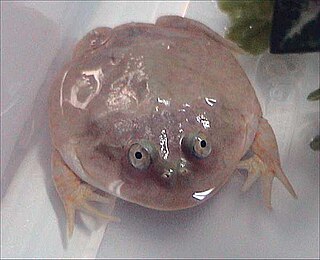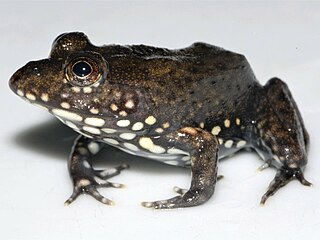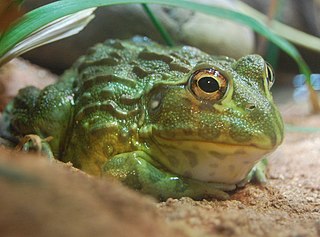
Edalorhina is a small genus of leptodactylid frogs. They are found in Colombia, Ecuador, Peru and western Brazil. They are sometimes known as the snouted frogs.

Lepidobatrachus is a genus of ceratophryidid frogs. They are commonly known as Paraguay horned frogs or Budgett's frogs, although the latter technically describes a specific species, Lepidobatrachus laevis.

Aubria is a small genus of frogs, with two known species. All members of this genus are found in West Africa. Their common name is ball frogs or fishing frogs.

Conraua, known as slippery frogs or giant frogs is a genus of large frogs from sub-Saharan Africa. Conraua is the only genus in the family Conrauidae. Alternatively, it may be placed in the family Petropedetidae.
Amphibian Species of the World 6.2: An Online Reference (ASW) is a herpetology database. It lists the names of frogs, salamanders and other amphibians, which scientists first described each species and what year, and the animal's known range.

Euproctus, the European mountain salamanders, is a genus of salamanders in the family Salamandridae from Sardinia and Corsica.
Hylodes vanzolinii is a species of frog in the family Hylodidae.
Paratelmatobius gaigeae is a species of frog in the family Leptodactylidae. It is endemic to Serra da Bocaina, a part of Serra do Mar, southeastern Brazil. Paratelmatobius gaigeae is named after Helen Beulah Thompson Gaige, an American herpetologist.
Paratelmatobius lutzii is a species of frog in the family Leptodactylidae. The species is endemic to Brazil, where it is known from the Mantiqueira Mountains in the state of Minas Gerais. Its natural habitats are montane forests. It is only known from its type locality where it was once abundant, but it has not been seen there after 1978.

Paratelmatobius poecilogaster is a species of frog in the family Leptodactylidae. It is endemic to the Serra do Mar range, Brazil. It is a terrestrial frog found near small temporary streams inside primary forest. The eggs are laid in small ponds at the edges of the temporary streams. Though the known populations are known from inside protected areas, it is likely to be threatened by habitat loss outside those areas.
Pleurodema bibroni is a species of frog in the family Leptodactylidae. Its common name is four-eyed frog, although this name can also refer to the genus Pleurodema in general. The common name refers to two inguinal poison glands that resemble eyes. When threatened, the frog lowers its head and raises its rear. When the frog adopts this posture the poison glands are also raised toward the predator. The predator may also confuse the frog's raised posterior for the head of a larger animal.

Dermatonotus is a genus of frogs in the family Microhylidae. It is monotypic, being represented by the single species, Dermatonotus muelleri, commonly known as Muller's termite frog. It is found in Argentina, Bolivia, Brazil, and Paraguay.

Cacosternum is a genus of frog in the family Pyxicephalidae that are found in southern and eastern Africa. They have many common names, including cacos, dainty frogs, and metal frogs.

The Petropedetidae are a family of frogs containing three genera and 12 species. They are found in sub-Saharan tropical Africa and are sometimes known under common name African torrent frogs.

Adelphobates is a small genus of poison dart frogs. They are found in the central and lower Amazon basin of Peru and Brazil, possibly Bolivia. It was originally erected as a sister group to the Dendrobates and Oophaga genera. The validity of the genus is still being discussed, with the alternative being "Dendrobates galactonotus group" within Dendrobates. One species originally placed in this genus as Adelphobates captivus has since been moved to the genus Excidobates erected in 2008.

The Pyxicephalidae are a family of frogs currently found in sub-Saharan Africa. However, in the Eocene, the taxon Thaumastosaurus lived in Europe.

The frog family Dicroglossidae occurs in tropical and subtropical regions of Asia and Africa, with most genera and species being found in Asia. The common name of the family is fork-tongued frogs.

Craugastoridae, commonly known as fleshbelly frogs, is a family of New World direct-developing frogs. As delineated here, following the Amphibian Species of the World, it contains 129 species. They are found from the southern United States southwards to Central and South America.

The Odontophrynidae are a family of frogs from southern and eastern South America. This family was first established in 1969 as the tribe Odontophrynini within the (then) very large family Leptodactylidae. Molecular phylogenetics analyses prompted the move of this group to the Cycloramphidae in 2006, before they became recognized as their own family Odontophrynidae in 2011.
Paratelmatobius yepiranga is a frog in the family Leptodactylidae. Scientists know it exclusively from its type locality in Parque das Neblinas in São Paulo, Brazil.














